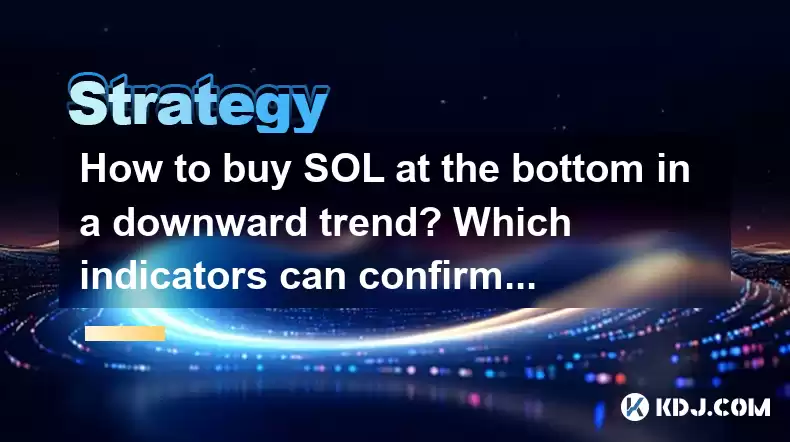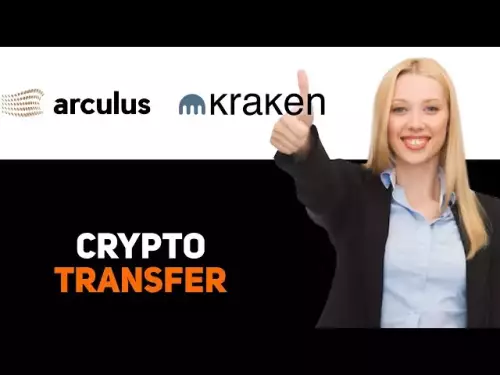-
 bitcoin
bitcoin $114684.631706 USD
-0.87% -
 ethereum
ethereum $4228.677447 USD
1.58% -
 bnb
bnb $1294.880693 USD
-1.16% -
 tether
tether $1.000819 USD
-0.02% -
 xrp
xrp $2.605138 USD
2.79% -
 solana
solana $209.908690 USD
5.89% -
 usd-coin
usd-coin $0.999903 USD
-0.03% -
 dogecoin
dogecoin $0.213423 USD
2.93% -
 tron
tron $0.322721 USD
-0.10% -
 cardano
cardano $0.727247 USD
3.66% -
 hyperliquid
hyperliquid $42.339456 USD
6.05% -
 chainlink
chainlink $19.910811 USD
5.16% -
 ethena-usde
ethena-usde $1.000557 USD
0.00% -
 stellar
stellar $0.349734 USD
2.69% -
 bitcoin-cash
bitcoin-cash $543.848687 USD
-0.21%
How to buy SOL at the bottom in a downward trend? Which indicators can confirm the bottom signal?
SOL's high speeds and low costs make it popular; buying at the bottom of a downward trend can be profitable if market indicators like RSI and MACD align.
May 02, 2025 at 09:21 pm

Understanding SOL and Market Trends
SOL, the native cryptocurrency of the Solana blockchain, is known for its high transaction speeds and low costs, making it a popular choice among traders and investors. In a downward trend, the price of SOL decreases over time, presenting both risks and opportunities. Buying at the bottom of such a trend can potentially lead to significant profits if the price rebounds. However, identifying the bottom accurately is challenging and requires a deep understanding of market indicators and trends.
Importance of Identifying the Bottom
Identifying the bottom in a downward trend is crucial for maximizing potential returns. Buying at the bottom allows investors to purchase SOL at a lower price, which can lead to higher profits if the market rebounds. However, mistaking a temporary dip for the bottom can result in significant losses if the price continues to fall. Therefore, it's essential to use reliable indicators to confirm the bottom signal before making a purchase.
Key Indicators for Confirming the Bottom
Several technical indicators can help confirm the bottom signal in a downward trend. Here are some of the most effective ones:
Relative Strength Index (RSI)
The Relative Strength Index (RSI) is a momentum oscillator that measures the speed and change of price movements. An RSI value below 30 typically indicates that an asset is oversold and may be due for a rebound. To confirm the bottom signal using RSI:
- Open your trading platform and navigate to the SOL chart.
- Add the RSI indicator to the chart.
- Monitor the RSI value. If it drops below 30, it may indicate that SOL is oversold and potentially at the bottom of the trend.
Moving Average Convergence Divergence (MACD)
The Moving Average Convergence Divergence (MACD) is another useful indicator for identifying trend reversals. A bullish crossover, where the MACD line crosses above the signal line, can signal a potential bottom. To use MACD for confirming the bottom:
- Add the MACD indicator to the SOL chart on your trading platform.
- Watch for the MACD line to cross above the signal line, which may indicate that the downward trend is reversing.
Bollinger Bands
Bollinger Bands consist of a middle band (a simple moving average) and two outer bands that are standard deviations away from the middle band. When the price touches or moves outside the lower band, it can indicate that the asset is oversold. To use Bollinger Bands for confirming the bottom:
- Add Bollinger Bands to the SOL chart.
- Look for instances where the price touches or moves below the lower band, which may suggest that SOL is at the bottom of the trend.
Volume
Volume is a crucial indicator for confirming the bottom signal. An increase in trading volume at a potential bottom can indicate strong buying interest and a possible trend reversal. To use volume for confirming the bottom:
- Monitor the volume on the SOL chart.
- Look for a significant increase in volume when the price is at a potential bottom, which can confirm that the bottom signal is valid.
Combining Indicators for Greater Accuracy
While each indicator can provide valuable insights, combining multiple indicators can increase the accuracy of identifying the bottom. For example, if the RSI indicates that SOL is oversold, the MACD shows a bullish crossover, and the price touches the lower Bollinger Band with increased volume, these signals together can provide a strong confirmation of the bottom.
Practical Steps to Buy SOL at the Bottom
To buy SOL at the bottom in a downward trend, follow these practical steps:
- Set up your trading platform: Ensure you have a reliable cryptocurrency exchange account with access to SOL trading pairs.
- Monitor the market: Keep an eye on the SOL price chart and the indicators mentioned above.
- Wait for the indicators to align: Look for the RSI to drop below 30, the MACD to show a bullish crossover, the price to touch the lower Bollinger Band, and an increase in volume.
- Place your order: Once the indicators confirm the bottom signal, place a buy order for SOL at the current price.
- Set stop-loss and take-profit orders: To manage risk, set a stop-loss order below your purchase price and a take-profit order at your desired profit level.
Frequently Asked Questions
Q: Can fundamental analysis help in identifying the bottom of a downward trend for SOL?A: Fundamental analysis can provide insights into the long-term value and potential of SOL but is less effective for pinpointing short-term market bottoms. Technical indicators are more suitable for identifying the bottom in a downward trend.
Q: Is it possible to automate the process of buying SOL at the bottom using trading bots?A: Yes, trading bots can be programmed to monitor technical indicators and execute trades automatically when certain conditions are met. However, setting up such bots requires a good understanding of both trading and programming.
Q: How often should I check the indicators to confirm the bottom signal for SOL?A: It's advisable to check the indicators at least daily, especially during a downward trend. However, in highly volatile markets, more frequent checks (e.g., every few hours) may be necessary to capture the bottom signal accurately.
Q: What should I do if the price of SOL continues to fall after I buy at what I thought was the bottom?A: If the price continues to fall after your purchase, consider adjusting your stop-loss order to minimize losses. It's also important to reassess the market conditions and indicators to determine if you need to exit the position or hold for a potential rebound.
Disclaimer:info@kdj.com
The information provided is not trading advice. kdj.com does not assume any responsibility for any investments made based on the information provided in this article. Cryptocurrencies are highly volatile and it is highly recommended that you invest with caution after thorough research!
If you believe that the content used on this website infringes your copyright, please contact us immediately (info@kdj.com) and we will delete it promptly.
- XRP Price Prediction: Weekend Rollercoaster or Rally?
- 2025-10-12 08:45:16
- Bittensor (TAO): Super Bullish Signals Point to Potential 2x Rally
- 2025-10-11 10:25:12
- Silver Price Correction: Navigating the Dip & Identifying Key SEO Keywords
- 2025-10-11 10:25:12
- Decoding Crypto Trends: Bittensor's Bull Run, Cardano's Dip, and LivLive's Presale Buzz in 'Uptober 2025'
- 2025-10-12 08:45:16
- MoonBull: The Crypto Meme Coin Promising 1000x Gains?
- 2025-10-11 10:30:01
- Crypto Payroll Revolution: Stablecoins, Altcoins, and the Future of Salary Payments
- 2025-10-11 10:30:01
Related knowledge

Practical parameter settings for a Bitcoin multi-timeframe moving average system
Sep 18,2025 at 10:54pm
Optimizing Timeframe Combinations for Bitcoin Trading1. Selecting appropriate timeframes is crucial when building a multi-timeframe moving average sys...

How can I filter out false breakouts in Dogecoin high-frequency trading?
Sep 22,2025 at 01:00am
Understanding False Breakouts in Dogecoin Trading1. A false breakout occurs when Dogecoin's price appears to move beyond a defined support or resistan...

Techniques for identifying tops and bottoms in the Bitcoin on-chain NVT model
Sep 20,2025 at 07:54pm
Understanding the NVT Model in Bitcoin Analysis1. The Network Value to Transactions (NVT) ratio is often described as the 'P/E ratio' of the cryptocur...

What does the surge in open interest in Bitcoincoin futures mean?
Sep 20,2025 at 11:18pm
Understanding the Surge in Dogecoin Futures Open Interest1. A surge in open interest within Dogecoin futures indicates a growing number of active cont...

How can I use the Ethereum USDT premium to gauge market sentiment?
Sep 18,2025 at 11:55pm
Understanding the Ethereum USDT Premium1. The Ethereum USDT premium refers to the price difference between USDT (Tether) traded on Ethereum-based plat...

What should I do if Ethereum staking yields decline?
Sep 20,2025 at 06:18am
Understanding the Causes Behind Declining Ethereum Staking Yields1. The Ethereum network transitioned to a proof-of-stake consensus mechanism with the...

Practical parameter settings for a Bitcoin multi-timeframe moving average system
Sep 18,2025 at 10:54pm
Optimizing Timeframe Combinations for Bitcoin Trading1. Selecting appropriate timeframes is crucial when building a multi-timeframe moving average sys...

How can I filter out false breakouts in Dogecoin high-frequency trading?
Sep 22,2025 at 01:00am
Understanding False Breakouts in Dogecoin Trading1. A false breakout occurs when Dogecoin's price appears to move beyond a defined support or resistan...

Techniques for identifying tops and bottoms in the Bitcoin on-chain NVT model
Sep 20,2025 at 07:54pm
Understanding the NVT Model in Bitcoin Analysis1. The Network Value to Transactions (NVT) ratio is often described as the 'P/E ratio' of the cryptocur...

What does the surge in open interest in Bitcoincoin futures mean?
Sep 20,2025 at 11:18pm
Understanding the Surge in Dogecoin Futures Open Interest1. A surge in open interest within Dogecoin futures indicates a growing number of active cont...

How can I use the Ethereum USDT premium to gauge market sentiment?
Sep 18,2025 at 11:55pm
Understanding the Ethereum USDT Premium1. The Ethereum USDT premium refers to the price difference between USDT (Tether) traded on Ethereum-based plat...

What should I do if Ethereum staking yields decline?
Sep 20,2025 at 06:18am
Understanding the Causes Behind Declining Ethereum Staking Yields1. The Ethereum network transitioned to a proof-of-stake consensus mechanism with the...
See all articles

























![[4K 60fps] Prisma by novichokk (1 Coin) [4K 60fps] Prisma by novichokk (1 Coin)](/uploads/2025/10/14/cryptocurrencies-news/videos/k-fps-prisma-novichokk-coin/68ee49804ba00_image_500_375.webp)
















































